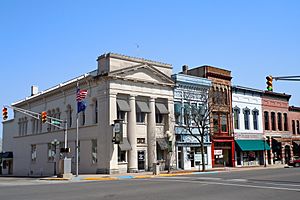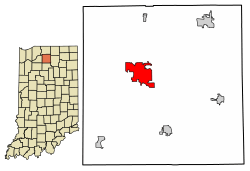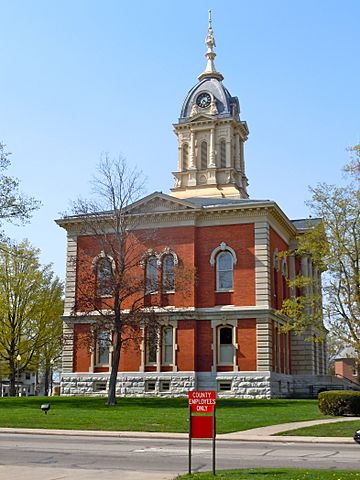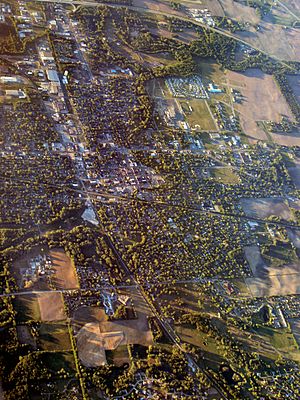Plymouth, Indiana facts for kids
Quick facts for kids
City of Plymouth
|
|
|---|---|

Downtown Plymouth
|
|

Location of Plymouth in Marshall County, Indiana.
|
|
| Country | United States |
| State | Indiana |
| County | Marshall |
| Area | |
| • Total | 7.62 sq mi (19.74 km2) |
| • Land | 7.57 sq mi (19.61 km2) |
| • Water | 0.05 sq mi (0.13 km2) 0.53% |
| Elevation | 797 ft (243 m) |
| Population
(2020)
|
|
| • Total | 10,214 |
| • Density | 1,349.10/sq mi (520.88/km2) |
| Time zone | UTC-5 (EST) |
| • Summer (DST) | UTC-4 (EDT) |
| ZIP code |
46563
|
| Area code(s) | 574 |
| FIPS code | 18-60822 |
| GNIS feature ID | 0441379 |
| Website | http://www.plymouthin.com |
Plymouth is a city in Marshall County, Indiana, United States. The population is 9,033 in the 2020 census. It is the county seat of Marshall County. Plymouth was the site of the first retail outlet of defunct U.S. retailer Montgomery Ward in 1926.
Contents
Geography
Plymouth, Indiana is located at 41°20′38″N 86°18′45″W / 41.34389°N 86.31250°W (41.343894, -86.312544), along the Yellow River.
According to the 2010 census, Plymouth has a total area of 7.57 square miles (19.61 km2), of which 7.53 square miles (19.50 km2) (or 99.47%) is land and 0.04 square miles (0.10 km2) (or 0.53%) is water.
Demographics
| Historical population | |||
|---|---|---|---|
| Census | Pop. | %± | |
| 1860 | 1,277 | — | |
| 1870 | 2,482 | 94.4% | |
| 1880 | 2,570 | 3.5% | |
| 1890 | 2,728 | 6.1% | |
| 1900 | 3,656 | 34.0% | |
| 1910 | 3,838 | 5.0% | |
| 1920 | 4,338 | 13.0% | |
| 1930 | 5,290 | 21.9% | |
| 1940 | 5,713 | 8.0% | |
| 1950 | 6,704 | 17.3% | |
| 1960 | 7,558 | 12.7% | |
| 1970 | 7,661 | 1.4% | |
| 1980 | 7,693 | 0.4% | |
| 1990 | 8,303 | 7.9% | |
| 2000 | 9,840 | 18.5% | |
| 2010 | 10,033 | 2.0% | |
| 2020 | 10,214 | 1.8% | |
| U.S. Decennial Census | |||
2010 census
As of the census of 2010, there were 10,033 people, 3,940 households, and 2,401 families residing in the city. The population density was 1,332.4 inhabitants per square mile (514.4/km2). There were 4,451 housing units at an average density of 591.1 per square mile (228.2/km2). The racial makeup of the city was 87.2% White, 0.9% African American, 0.6% Native American, 0.5% Asian, 8.3% from other races, and 2.5% from two or more races. Hispanic or Latino of any race were 20.0% of the population.
There were 3,940 households, of which 34.6% had children under the age of 18 living with them, 39.7% were married couples living together, 14.9% had a female householder with no husband present, 6.3% had a male householder with no wife present, and 39.1% were non-families. 33.5% of all households were made up of individuals, and 15% had someone living alone who was 65 years of age or older. The average household size was 2.49 and the average family size was 3.19.
The median age in the city was 34.3 years. 27.9% of residents were under the age of 18; 9.3% were between the ages of 18 and 24; 25.9% were from 25 to 44; 21.9% were from 45 to 64; and 15.2% were 65 years of age or older. The gender makeup of the city was 47.9% male and 52.1% female.
History

This area was part of the territory of the Potawatomi Native Americans, one of the historical tribes encountered by European-American settlers. In the nineteenth century, the United States government made numerous treaties to buy and extinguish Native American claims to land in the former Northwest Territory and the Southeast.
Marshall County was formed in 1836, during the early years of settlement and before the forced removal of the Potawatomi people in 1838. It was named for U.S. Chief Justice John Marshall, who died in 1835. Marshall County is notable as the starting point in 1838 of the Potawatomi Trail of Death, which was the forced removal by United States forces of Chief Menominee and 859 Potawatomi Indians from Indiana to Indian Territory, at the site of present-day Osawatomie, Kansas, a distance of 660 miles (1,060 km). The first settlers arrived in what is now Marshall County in 1835. They arrived as a result of the end of the Black Hawk War as well as the completion of the Erie Canal. They consisted primarily of settlers from New England, "Yankees" descended from the English Puritans who settled New England in the colonial era. They were mainly members of the Congregational Church, although due to the Second Great Awakening many of them had converted to Methodism and some had become Baptists before coming to what is now Marshall County. As a result of this heritage, some place names in Marshall County are named after places in New England, such as Plymouth, which is named after Plymouth, Massachusetts, the site where the Mayflower landed in 1620. When these settlers arrived, there was nothing but a dense virgin forest and wild marshland, which would need to be cleared and drained before it could be farmed. The Indian Removal Act of 1830 authorized forcible removal if necessary. The United States government purchased this area under the Treaty of Tippecanoe in 1832.
Although many Potawatomi had relocated to Indian Territory in present-day Kansas, Chief Menominee and his band of the Yellow River refused to go. Militia under the authority of United States Army officers rounded them up and in September 1838, the band of 859 headed west, in what became known as the Potawatomi Trail of Death. They traveled more than 660 miles to Osawatomie, Kansas, with many of the Potawatomi walking. More than 40 of the tribal members died on the march.
Plymouth was incorporated as a town in 1851.
During the Civil War, Union Army soldiers arrested Daniel E. VanValkenburgh, editor of the Plymouth Weekly Democrat, who criticized what he viewed as Lincoln’s abuses of power. VanValkenburgh also criticized Department of Ohio commander Ambrose Burnside’s lieutenant, General Milo S. Hascall. Hascall was in charge of the District of Indiana. VanValkenburgh called Hascall a donkey in the pages of the Democrat. Hascall promptly dispatched soldiers to arrest VanValkenburgh and brought him before Burnside to answer charges of violating Burnside's General Order No. 38. Burnside let VanValkenburgh off with a warning. The Democrat became the first of eleven Democratic newspapers suppressed or threatened with suppression in May 1863.
Much of Plymouth's history was documented in two major newspapers during the 19th century. The Marshall County Republican (also titled Plymouth Republican and Plymouth Tribune) operated from 1856 to 1922. Its main rival the Marshall County Democrat (also titled Plymouth Democrat) appeared from 1855 to 1932 (and as a weekly only edition until January 1, 1941). During the 20th century, the Plymouth Daily Pilot acquired the Republican in 1922, and the Democrat became the Plymouth Daily News in 1932. The News and Pilot merged to become the Plymouth Pilot-News in 1947.
As part of Plymouth's sesquicentennial celebration in 1966, organizers created the first Marshall County Blueberry Festival, to take place over Labor Day weekend. This tradition has continued annually, and the Festival typically brings in tens of thousands of visitors over the 4-day event.
In July 1982, five firefighters were killed when their fire truck overturned while responding to a call. The tanker truck crashed on a curve near West School on state road 17.
The East Laporte Street Footbridge, Heminger Travel Lodge, Marshall County Courthouse, Plymouth Downtown Historic District, Plymouth Northside Historic District, Plymouth Southside Historic District, and Plymouth Fire Station are listed on the National Register of Historic Places.
Plymouth High School
2008 - Plymouth High School is awarded the Bronze Award from U.S. News & World Report. Also, PHS was named one of Indiana's "Best Buy Schools" by the Indiana State Chamber of Commerce.
Student Programs
The Plymouth School Corporation has around 85 extra curricular activities, including a robotics club, Lego League, Academic clubs such as Spell Bowl and Quiz Bowl, Language Clubs, and a variety of other Instrumental, Sport, and Speech programs.
Instrumental Music
The Plymouth High School Instrumental Music Department has annually earned the ISSMA "All-Music Award" and the marching band was named an ISSMA State Finalist in 2010 and 2013. The "Winter Performance Ensemble" (W.P.E.) combines Winter Drumline and Winter Guard into one ensemble. The W.P.E. began in 2010 and was an IPA state finalist and the IHSCGA Class 3A Divisional Champions. In 2011, the ensemble was an IPA state finalist. In 2012, the ensemble was promoted to Class PSA in the percussion association and was also a state finalist. In 2016 the Pride of Plymouth participated in their first season of WGI Winds, in the Scholastic World Winds class, and ranked second in the Winds Championship Finals.
Speech
The Plymouth High School Speech Team has been successful on both the state and national levels. The team was the overall Indiana High School Forensic Association's state champion in 1997, as well as five consecutive years from 2000 to 2004, and also in 2009. As the champions, the team won the Ralph Lawson Trophy. The team also won the Class "AA" state championship each year from 1997 to 2004 and 2006 to 2009.
On the national level, Plymouth students regularly compete at the National Forensic League's national tournament. Plymouth students have earned national championships in Original Oratory in 2002, Duo Interpretation in 2004, and Prose Reading in 2005. In 2007, Head Coach David McKenzie was awarded the National Forensic League National Coach of the Year.
Athletics
In 1977, Plymouth High School won the State Football Championship.
In 1982, Scott Skiles led Plymouth High School to the boys basketball state championship, with a 75-74 double overtime victory over Gary Roosevelt High School. On March 24, 2007, Plymouth won the Indiana Class AAA boys' basketball championship. Plymouth beat Evansville Bosse in a 72-61 victory. Head coach Jack Edison was named National High School coach of the year. On March 1, 2008, Plymouth won the Indiana Class AAA Girls' Basketball Championship. The Lady Pilgrims defeated Indianapolis Chatard 47-46 at Conseco Fieldhouse in Indianapolis.
In 2012, Plymouth native Morgan Uceny qualified for the 2012 Summer Olympics. She ran in the 1500 m final, but did not finish the race after falling on the last turn.
Awards
Plymouth ranks #4 on the Niche "Best Towns to Raise a Family in Indiana" list and #94 on the "Best Towns to Raise a Family in America" list.
Plymouth was ranked #8 in the "Top 10 Safest Midsize Cities in Indiana" according to ValuePenguin.
Economy
As the center of commerce for Marshall County, Plymouth provides a large percentage of jobs in the manufacturing, retail, and service sectors. Major manufacturing employers include Hoosier Racing Tire, Zentis, Pregis Innovative Packaging, and the Maax Corporation. Seven U.S. manufacturing headquarters are located in Plymouth: American Containers, Inc., Arrow Services, Inc., Indiana Tool & Manufacturing, Co. Inc (ITAMCO) U.S. Granules Corp., Wiers Manufacturing, Inc. and Zentis North America, LLC.
Notable residents
Entertainers
- Raymond Walburn was born in Plymouth but moved to Oakland, California to pursue an acting career. He acted in films from 1916 to 1955.
- Nick and Will Kubley of Plymouth were involved in Kidz Bop. Kidz Bop makes kid-friendly versions of popular songs. Afterwards they would go on to form Passafire, a group that makes nursery rhyme versions of reggae songs.
Athletes and Coaches
- Noble Kizer played football at the University of Notre Dame under coach Knute Rockne from 1922 to 1924. Stood as Purdue University's head football coach from 1930 to 1936. Kizer was inducted into the Indiana Football Hall of Fame in 1977.
- Steve Yoder was born in Plymouth and graduated from Plymouth High School in 1958. Yoder went on the Illinois Wesleyan University where he pursued basketball and baseball. He began his coaching career prior to receiving his master's degree by coaching a junior high basketball team in Glen Ellyn, Illinois. Yoder became Plymouth High School's head basketball coach in 1967 and was named District One Coach of the Year after his final year at Plymouth in 1973. In 1975, after serving as Furman University's assistant coach, he returned to Indiana where he became Penn High School head coach. However, he became Ball State University's assistant coach the year after, and their head coach the next year. Yoder held the head coaching position at Ball State University from 1977 to 1982. He stood as head coach at the University of Wisconsin–Madison for the next ten years before he went to work for the Indiana Pacers and New York Knicks as a scout.
- Scott Skiles graduated from Plymouth High School in 1982 then went on to play basketball for and graduate from Michigan State University in 1986. He has played for Milwaukee Bucks, Indiana Pacers, Orlando Magic, Washington Bullets, Philadelphia 76ers, and PAOK Thessaloniki (Greek basketball league). He coached for the Phoenix Suns, Chicago Bulls, Milwaukee Bucks, and Orlando Magic. His playing career lasted from 1986 to 1997; his coaching career began in 1997. On December 30, 1990 Skiles broke the single-game assist record while playing for the Orlando Magic. He had 30 assists vs. the Denver Nuggets and the record stands to this day.
- Morgan Uceny born in Plymouth graduated from Cornell University in 2007 as a four-time All-American. Won the National Title for the 1500m which qualified her for the 2012 Olympics in London.
See also
 In Spanish: Plymouth (Indiana) para niños
In Spanish: Plymouth (Indiana) para niños




